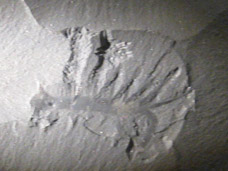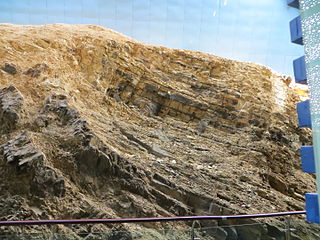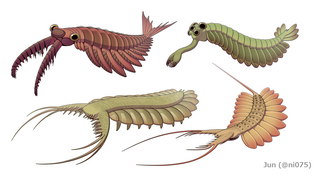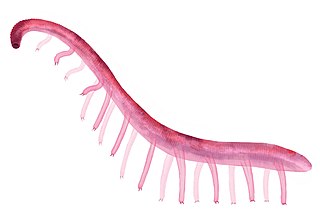
The lobopodians, members of the informal group Lobopodia, or the formally erected phylum Lobopoda Cavalier-Smith (1998), are panarthropods with stubby legs called lobopods, a term which may also be used as a common name of this group as well. While the definition of lobopodians may differ between literatures, it usually refers to a group of soft-bodied, worm-like fossil panarthropods such as Aysheaia and Hallucigenia.

Hallucigenia is a genus of Cambrian xenusiids known from articulated fossils in Burgess Shale-type deposits in Canada and China, and from isolated spines around the world. The generic name reflects the type species' unusual appearance and eccentric history of study; when it was erected as a genus, H. sparsa was reconstructed upside down and back to front. Hallucigenia is now recognized as a "lobopodian worm". It is considered by some to represent an early ancestor of the living velvet worms, although other researchers favour a relationship closer to arthropods.

The Maotianshan Shales are a series of Early Cambrian deposits in the Chiungchussu Formation, famous for their Konservat Lagerstätten, deposits known for the exceptional preservation of fossilized organisms or traces. The Maotianshan Shales form one of some forty Cambrian fossil locations worldwide exhibiting exquisite preservation of rarely preserved, non-mineralized soft tissue, comparable to the fossils of the Burgess Shale. They take their name from Maotianshan Hill in Chengjiang County, Yunnan Province, China.

Opabinia regalis is an extinct, stem group arthropod found in the Middle Cambrian Burgess Shale Lagerstätte of British Columbia. Opabinia was a soft-bodied animal, measuring up to 7 cm in body length, and its segmented trunk had flaps along the sides and a fan-shaped tail. The head shows unusual features: five eyes, a mouth under the head and facing backwards, and a clawed proboscis that probably passed food to the mouth. Opabinia probably lived on the seafloor, using the proboscis to seek out small, soft food. Fewer than twenty good specimens have been described; 3 specimens of Opabinia are known from the Greater Phyllopod bed, where they constitute less than 0.1% of the community.
Aysheaia is an extinct genus of soft-bodied lobopod, known from the middle Cambrian of North America, the average body length is of 1–6 cm.

Xenusion auerswaldae is an early lobopodian known from two specimens found in glacial debris in Germany. They probably originated in the Kalmarsund Sandstone of Southern Sweden, which was deposited in the Lower Cambrian. The specimens are not especially well preserved. The older specimen is 10 cm or so in length with a narrow, weakly segmented body. A depression runs up the bottom on all but the rearmost segments. There is a slightly bulbous termination, and each segment beyond that seems to have a single pair of tapering annulated legs similar to the modern onychophoran, but without claws. Nine segments are present. There is a spine on each body bump and faint transverse parallel striations on the annulations on the legs. The legs of what is possibly the foremost segments are either missing or not preserved. The head is believed to be missing or is poorly preserved. If Xenusion is an lobopodian, it is one of the oldest currently known fossils of a mobile, modern animal.

Dinocaridida is a proposed fossil taxon of basal arthropods flourished in the Cambrian period with occasional Ordovician and Devonian records. Characterized by a pair of frontal appendages and series of body flaps, the name of Dinocaridids comes from Greek, "deinos" and "caris", referring to the suggested role of some of these members as the largest marine predators of their time. Dinocaridids are occasionally referred to as the 'AOPK group' by some literatures, as the group compose of Radiodonta, Opabinia, Pambdelurion and Kerygmachela. It is most likely paraphyletic, with Kerygmachela and Pambdelurion more basal than the clade compose of Opabinia, Radiodonta and other arthropods.

Parapeytoia was a prehistoric animal that lived over 530 million years ago in the Maotianshan shales of prehistoric China. It was interpreted as an anomalocaridid (radiodont) with legs, but later studies reveal it was a megacheiran, a group of arthropods which are no longer thought to be closely related to the radiodonts.

Paucipodia inermis is a lobopod known from the Lower Cambrian Chengjiang lagerstätte. Its gut is puzzling; in some places, it is preserved in three dimensions, infilled with sediment; whereas in others it may be flat. These cannot result from phosphatisation, which is usually responsible for three-dimensional gut preservation, for the phosphate content of the guts is under 1% – the contents comprise quartz and muscovite. Its fossils do not suggest it had any sclerites, especially when compared with the related Hallucigenia.

Jianshanopodia decora is a Cambrian lobopodian. Its frontal, grasping appendages bear wedge-shaped plates. Its limbs branch, instead of being tipped with claws as many lobopods' are. It has a sediment-filled gut surrounded by serially repeated diverticulae. It is thought to have sucked up prey with its short 'trunk'. It mainly crawled on the sea floor, but could swim when necessary. Its mouth resembles those of anomalocaridids and priapulids.

Radiodonta is an order of stem-group arthropods that was successful worldwide during the Cambrian period. They may be referred to as radiodonts, radiodontans, radiodontids, anomalocarids, or anomalocaridids, although the latter originally refer to the family Anomalocarididae, which previously included all species of this order but is now restricted to only a few species. Radiodonts are distinguished by their distinctive frontal appendages, which are morphologically diverse and used for a variety of functions. Radiodonts included the earliest large predators known, but they also included sediment sifters and filter feeders. Some of the most famous species of radiodonts are the Cambrian taxa Anomalocaris canadensis, Hurdia victoria, Peytoia nathorsti, and Amplectobelua symbrachiata, the Ordovician Aegirocassis benmoulai and the Devonian Schinderhannes bartelsi.

Cucumericrus decoratus is a species of putative radiodont (anomalocaridid) known from a few poorly preserved specimens. Only fragments of trunk cuticle and corresponded appendages had been revealed, while important radiodont features such as frontal appendages are unknown in this species. The trunk cuticle possess irregular wrinkles and may had been soft in life. Each of the trunk appendage compose of a dorsal flap-like element and a ventral stubby leg with unknown distal region, structurally comparable to the trunk appendages of gill lobopodians and euarthropod biramous appendages. The legs have been interpreted as somewhere between annulated lobopod legs and segmented arthropod legs.

Omnidens amplus, meaning "large all-tooth", is an extinct species of large Cambrian animal known only from a series of large mouth apparatus, originally mistaken as the mouthparts of anomalocaridids. When first named, it was interpreted as a giant priapulid, but is now considered a panarthropod. Its mouth apparatus closely resembles that of the smaller gilled lobopodian Pambdelurion, indicating it is likely to have been a close relative of that species, with which it may be synonymous. With a maximum estimated body length of 1.5 metres (4.9 ft), Omnidens is the largest known free-living Cambrian organism. Omnidens fossils are found in the Maotianshan Shales.

Diania is an extinct genus of lobopodian animal found in the Lower Cambrian Maotianshan shale of China, represented by a single species D. cactiformis. Known during its investigation by the nickname "walking cactus", this organism belongs to a group known as the armoured lobopodians and has a simple worm-like body with robust, spiny legs. Initially, the legs were thought to have jointed exoskeleton and Diania was suggested to be close to the origins of arthropods, but many later studies have denied this interpretation.

The Luolishaniidae or Luolishaniida are a group of lobopodians with setiferous forelimbs known from the Cambrian period. The presence of thorn-shaped sclerites arranged as three per segment is diagnostic. The type genus is based on Luolishania longicruris Hou and Chen, 1989, from the Chengjiang Lagerstatte, South China. They are presumed to have been filter feeders. New specimens of the previously enigmatic Facivermis show that it was a sessile tube-dweller, and part of this group.

Antennacanthopodia is a rare unarmoured lobopodian from the Chengjiang biota, with prickly legs, a pair of 'antennae', and an onychophoran-like body outline. It also has a pair of frontal antennae, potential ocellus-like lateral visual organs, second antennae possibly homologous to the slime papillae of modern Onychophorans, a straight, voluminous midgut, diminutive spines arrayed on the leg and the trunk, well-developed leg musculature, highly sclerotized terminal leg pads, and presumptively a pair of posteriormost appendicules.
Tritonychus phanerosarkus is a Cambrian lobopodian, exceptionally preserved in the Orsten fashion by phosphate deposition, additionally preserving muscle fibres. Its name loosely translates to "Three-clawed animal with well displayed flesh". Phylogenetic analysis suggests that it was a close relative of the Onychophora, possibly even a member of the main lineage. The fossil was discovered in the Xiaotan section, Yongshan, Yunnan Province in the Yu'anshan Formation.

Megadictyon is a genus of cambrian lobopodian with similarities to Jianshanopodia and Siberion. Occasionally mis-spelt Magadictyon.

Squamacula is an extinct arthropod from the Cambrian Series 2, the type species S. clypeata was described in 1997 from the Chengjiang biota. At the time of description there were only two known specimens of S. clypeata, but now there are at least six known specimens. In 2012 a second species S. buckorum was described from the Emu Bay Shale of Australia.

Onychodictyon is a genus of extinct lobopodian known from the Lower Cambrian Chengjiang Maotianshan Shales in the Yunnan Province in China. It was characterized by a stout body covered by fleshy papillae and pairs of sclerotized plates with spines, representing part of the diverse "armoured lobopodians" alongside similar forms such as Microdictyon and Hallucigenia.

















